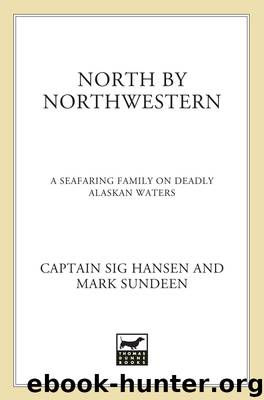North by Northwestern by Sig Hansen

Author:Sig Hansen
Language: eng
Format: epub
Publisher: St. Martin's Press
Norman at age six, and Edgar at age thirty-seven, with fine specimens of Alaskan king crab. (Left: Courtesy of the Hansen Family) (Right: Courtesy of EVOL)
Brown crab is also known as golden crab, and despite its name, it’s the smallest and least desirable of the Alaskan kings. They are orange or brown in color, and a bit smaller than the reds and blues.
King crab live on the ocean floor, and do not venture to shore. Most of the year they stay several hundred feet below the surface, but in late winter they migrate to shallow water, less than 160 feet deep, to molt, mate, and hatch their young. Crabs may migrate over a hundred miles.
Molting is how they shed their hard shell and reveal a new soft shell in its place, which will harden over the course of the year. Molting allows the females to reproduce. They breed through genital ducts called gonopores on their sternums. The male grasps the female and fertilizes somewhere between 50,000 and 500,000 eggs. I’m no scientist, and to be honest, I don’t totally understand how that procedure works.
The female stores the eggs under her tail flap for eleven months as she returns to deeper water. The next year, before molting, she travels to the shallows and lays her eggs. Millions and millions of embryos are released and hatched into larvae. The larvae swim and eat phytoplankton and zooplankton, or get eaten by larger creatures. They will molt four times before becoming recognizable as crab. For protection, juveniles between the age of two and four form pods made up of thousands and thousands of crabs that roll across the ocean floor in a big ball.
After four years, they may leave the pod, but they are still quite small—less than three inches across the carapace. Then they join the annual migration and spawning of adult crabs, and continue to grow toward maturity. Adults are omnivorous, and will feed on just about anything that comes their way: algae, worms, clams, mussels, sea stars, sea urchins, fungus, other crab, and of course, dead fish parts like the bait in our pots. Their main predators are large bottom-feeding fish such as halibut and cod, but if they can avoid pots and stalkers, they live ten to twenty years.
Sometimes the adults, like the juveniles, will form a pod of thousands of crab, a huge ball of biomass that rolls across the ocean floor. Just picture it—a pod that covers an area the size of several football fields, with crab ten or fifteen deep, pulsing and surging, legs and claws poking out every which way; hundreds of thousands of pounds of hard-shelled bugs swarming the ocean floor in a frenzy.
Right smack-dab in the middle of this pile is where we want our pots. Getting them there requires the elements I listed earlier: experience, science, cunning, instinct, and luck. First let’s look at experience.
Typically I take the boat to places I’ve been before. My dad and Tormod kept detailed logs of all the crab they pulled over the years.
Download
This site does not store any files on its server. We only index and link to content provided by other sites. Please contact the content providers to delete copyright contents if any and email us, we'll remove relevant links or contents immediately.
| Fisheries & Aquaculture | Forests & Forestry |
The Lonely City by Olivia Laing(4131)
Animal Frequency by Melissa Alvarez(3763)
All Creatures Great and Small by James Herriot(3528)
Walking by Henry David Thoreau(3238)
Exit West by Mohsin Hamid(3198)
Origin Story: A Big History of Everything by David Christian(3146)
COSMOS by Carl Sagan(2962)
How to Read Water: Clues and Patterns from Puddles to the Sea (Natural Navigation) by Tristan Gooley(2879)
Hedgerow by John Wright(2782)
The Inner Life of Animals by Peter Wohlleben(2777)
Origin Story by David Christian(2693)
How to Read Nature by Tristan Gooley(2670)
Project Animal Farm: An Accidental Journey into the Secret World of Farming and the Truth About Our Food by Sonia Faruqi(2668)
How to Do Nothing by Jenny Odell(2652)
Water by Ian Miller(2598)
A Forest Journey by John Perlin(2590)
The Plant Messiah by Carlos Magdalena(2459)
A Wilder Time by William E. Glassley(2367)
Forests: A Very Short Introduction by Jaboury Ghazoul(2338)
